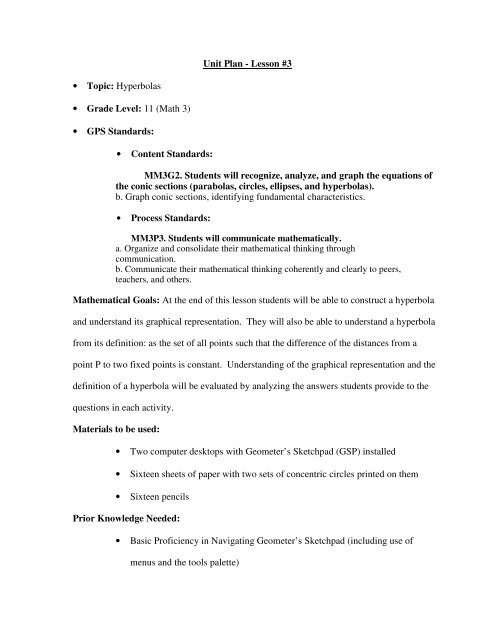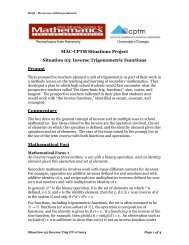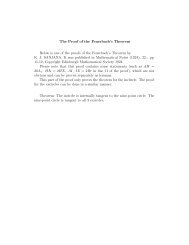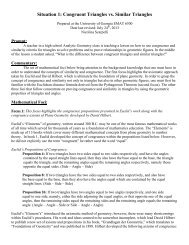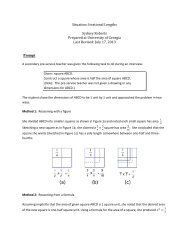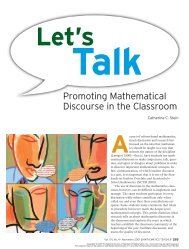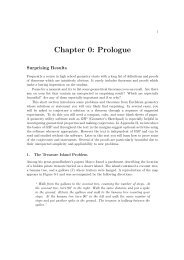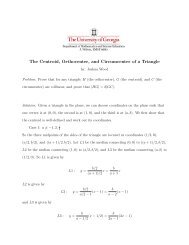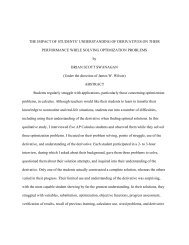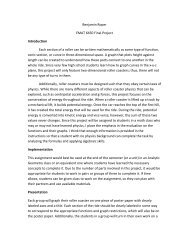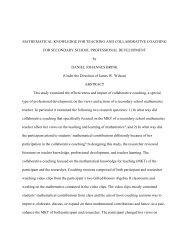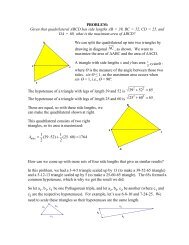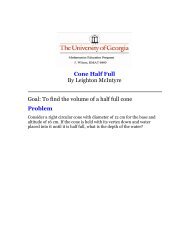Unit Plan - Lesson #3 • Topic: Hyperbolas • Grade Level: 11 (Math 3 ...
Unit Plan - Lesson #3 • Topic: Hyperbolas • Grade Level: 11 (Math 3 ...
Unit Plan - Lesson #3 • Topic: Hyperbolas • Grade Level: 11 (Math 3 ...
- No tags were found...
Create successful ePaper yourself
Turn your PDF publications into a flip-book with our unique Google optimized e-Paper software.
<strong>Unit</strong> <strong>Plan</strong> - <strong>Lesson</strong> <strong>#3</strong><strong>•</strong> <strong>Topic</strong>: <strong>Hyperbolas</strong><strong>•</strong> <strong>Grade</strong> <strong>Level</strong>: <strong>11</strong> (<strong>Math</strong> 3)<strong>•</strong> GPS Standards:<strong>•</strong> Content Standards:MM3G2. Students will recognize, analyze, and graph the equations ofthe conic sections (parabolas, circles, ellipses, and hyperbolas).b. Graph conic sections, identifying fundamental characteristics.<strong>•</strong> Process Standards:MM3P3. Students will communicate mathematically.a. Organize and consolidate their mathematical thinking throughcommunication.b. Communicate their mathematical thinking coherently and clearly to peers,teachers, and others.<strong>Math</strong>ematical Goals: At the end of this lesson students will be able to construct a hyperbolaand understand its graphical representation. They will also be able to understand a hyperbolafrom its definition: as the set of all points such that the difference of the distances from apoint P to two fixed points is constant. Understanding of the graphical representation and thedefinition of a hyperbola will be evaluated by analyzing the answers students provide to thequestions in each activity.Materials to be used:<strong>•</strong> Two computer desktops with Geometer’s Sketchpad (GSP) installed<strong>•</strong> Sixteen sheets of paper with two sets of concentric circles printed on them<strong>•</strong> Sixteen pencilsPrior Knowledge Needed:<strong>•</strong> Basic Proficiency in Navigating Geometer’s Sketchpad (including use ofmenus and the tools palette)
<strong>•</strong> Properties of Segments (including definition, midpoint, perpendicularsegments)<strong>•</strong> Properties of Lines (including definition, distance to a line)<strong>•</strong> Properties and Construction of Ellipses (from the first lesson)Out of the four conic sections, the hyperbola is the shape to which students probably have theleast amount of exposure. Up to this point in the Integrated GPS curriculum, the closest studentshave come to working with a hyperbolic shape is in the graphing of rational functions. This taskbuilds upon students’ previous exposure to and experience with constructing points and lines inthe coordinate plane. Although students have previously worked with these two objects in thecoordinate plane separately, they have not yet used them prior to this unit to find other points onthe plane. The definition of a hyperbola, the set of all points such that the difference of thedistances from a point P to two fixed points is constant, is the basis for the development of theunderstanding of hyperbolas. This task will also build on students’ prior exposure to ellipses inthe first lesson and compare the construction of ellipses to the construction of hyperbolas. Theseconnections are made in the task and in the closing discussion.Potential Challenges to Struggling Students or IEP/ELL StudentsAlthough much consideration has taken place to provide a thorough yet efficient lesson,there are potential challenges that might be met by students who struggle with basic concepts orby students who are either designated as English Language Learners (ELL) or have other SpecialEducation needs. The primary challenge that will be met will be in the usage of mathematicalterminology and vocabulary to describe the ideas and concepts covered in the lesson. This issuecan be addressed by restating mathematical terminology and vocabulary with simpler language.For example, if a student has difficulty understanding the meaning of the term “equidistant”, thenalternate terminology, such as “equal distance” or “same distance”, can be utilized. When
alternate terminology is employed along with drawings and other representations, this challengecan be minimized.There are also a multitude of potential challenges that can face students with SpecificLearning Disabilities (LD). The best method to pursue to address challenges to these studentsbegins with the teachers in the Special Education program. Collaboration with theseprofessionals will lead to strategies to address specific student concerns in the lesson.Classroom Setup:The classroom period is 50 minutes. After an introduction that provides the definition ofa parabola and connections to other academic subjects and everyday life, the students will besplit into three groups that will rotate through three stations. Each rotation will last one classperiod. One station will have the worksheets and pencils for constructing a hyperbola usingconcentric circles. The other two stations will each consist of a desktop computer withGeometer’s Sketchpad installed for dynamic constructions. Since there are sixteen students ineach class, two groups will have five students and the third group will have six students. Eachstudent will be engaged in one of five roles utilized at each station: instruction reader, instructionfollower, second instruction follower, question reader, and question answerer (writes answers toquestions on supplied worksheets). The extra student in the third group will share duties withanother group member. Students will switch roles as they rotate from station to station and willfill each role once.<strong>Lesson</strong> StructureI. IntroductionTo introduce the lesson, the basic properties of a hyperbola are presented. The graph of arational function is reviewed focusing on the different parts of the graph, including theasymptotes. Students are told that a hyperbola can be seen as two parabolas facing (or
opening) in opposite directions. On the Promethian Board, a GSP Sketch of a hyperbola isopened.The parts of the hyperbola are introduced, and the definition is provided to the students.This definition is compared to the definition of an ellipse, where the sum of the distances isconstant. The following questions are then posed: “How is the hyperbola similar to theellipse? How are they different?” Students are given an opportunity to make conjecturesthat are written on the board. The students are instructed to keep these ideas in mind as theyprogress through the lesson tasks. The tasks will be introduced along with the steps requiredto complete the tasks. Each group will be handed a packet of three pages, each page havingthe steps and questions to be answered at the end of each task.The review of the basic properties of lines, and points ensures access to all students, sincethe students, by the time they have reached <strong>Math</strong> III, have had multiple exposures to thesetopics in <strong>Math</strong> I and <strong>Math</strong> II. Cognitive demand is maintained throughout the task byfocusing students’ attention on procedures that are utilized to develop a better understandingof parabolas. By following the step-by-step procedures and by answering the questions thatfollow them, connections are established between students prior knowledge and the
underlying concepts involved with understanding parabolas. The tasks result in graphicalrepresentations of hyperbolas that, in later discussions, will lead to algebraic representationsthat are compared and contrasted to the equations of circles, parabolas, and ellipses, withgreater awareness of the connection between all four shapes. The questions that follow theprocedures force students to engage with the ideas and concepts so that the task can becompleted successfully and understanding is created.II. InvestigationDuring the investigation, each group goes to the assigned starting station. The students inthe group are allowed to pick the role they will assume in their starting station, with theunderstanding that each group member must fill a different role at each station until eachmember has filled all five roles. This change of roles will help to keep students engaged andminimize frustration with the task. Whenever possible, the teacher will have extra steps tofollow to extend the activity for students who finish the activity quickly. During theinvestigation the teacher will monitor group work, only joining the groups and posingquestions when needed, as well as making notes to select student responses for whole classdiscussion. Since the students are following “procedures with connections” tasks, steps arefollowed during the investigation phase that lead to solution strategies which are shared anddiscussed during the Whole Class Discussion Phase.
The tasks for each station are as follows:Station 1 uses the sheets of paper with concentric circles printed on them.There are two groups of seven concentric circles, one group centered at F1 and the othergroup centered at point F2. The radii of the circles each increase by one unit all the way upto seven units. Points F1 and F2 are the foci of an infinite number of hyperbolas, but in thisactivity we are only interested in constructing the hyperbola that passes through point A.The following questions/steps are asked at Station 1:<strong>•</strong> How many units apart are points A and F1? How many units apart are points A andF2? What is the numerical value for the difference between these two distances?<strong>•</strong> Locate and mark at least 16 points that sit on either branch of the hyperbola thatpasses through point A. How did you find them?
<strong>•</strong> Using the points you found as guidelines, sketch both branches of the hyperbola.Possible Solution Strategies for Station 1Students must take care to use the circles as representations of distance from the foci topoint A. As long as the students can find the distance from F1 to point A and from F2 topoint A and find the numerical difference between those two distances, the student should beable to use the circles to find other distances that can be subtracted to get the same numericaldifference. As long as they realize that the intersection points that yield the same differencein distance are on the hyperbola, then the points should be relatively easy to find.There is a possible difficulty that may arise with students who have visual perceptionproblems. These visual perception problems can cause students to count the incorrectnumber of circles, resulting in the students choosing incorrect intersection points. Thisproblem is alleviated by displaying each group of concentric circles in a different color.
Station 2 uses a desktop workstation with Geometer’s Sketchpad (GSP) installed on it tomodel the concentric circle exercise performed at Station 1. This activity will show how thehyperbola changes shape as its parts are relocated. A premade GSP sketch isopened that shows two circles, one red and one blue.The sizes of the two circles are controlled by the segments at the top of the screen. The redcircle has radius AC and the blue circle has radius BC. To operate this model point C is draggedand the radii adjust to remain equal to AC and BC. The intersections of the two circles are alsotraced as the circles change shape.The following questions are asked at Station 2:<strong>•</strong> As point C is dragged, changing the radii of both circles, there is a relationship thatexists between the two radii whenever C is not between A and B. What is thatrelationship?<strong>•</strong> Why do the circle intersection points trace a hyperbola?
<strong>•</strong> Select the two circles and choose Trace Circles from the Display menu, then dragpoint C. What similarities exist between this GSP construction and the ConcentricCircles activity from Station 1?Possible Solution Strategies for Station 2By observing the segment at the top of the screen, students can see that whenever point Cis not between A and B the difference between AC and BC is always AB. For this reason,since the difference is constant, the intersections of the two circles will trace a hyperbola.When the two circles are traced, the two circles create two groups of concentric circles, justlike the activity in Station 1.Station 3 uses a desktop workstation with Geometer’s Sketchpad (GSP) installed on it toextend the paper folding activity in Station 3 from the lesson on ellipses. In that construction,paper folds were created on circular pieces of paper so that the circumference of the paper liedon a point inside the circle, point B. In Station 4 of the same lesson on ellipses, a GSP sketchwas created that modeled that paper folding activity.
The following questions are asked at Station 3:<strong>•</strong> What happens to the ellipse when the focal point B is moved outside the circle?<strong>•</strong> To find the tangent point of the ellipse we constructed a line through points A and C,then found the intersection of this line with the crease line. Will this intersectionpoint still be tangent when B is moved outside the circle?Possible Solution Strategies for Station 3Simply by dragging point B outside the circle, the locus of crease lines now forms ahyperbola. Even though point B is moved outside the circle and the shape changes fromellipse to hyperbola, the intersection of line AC and the crease line is still tangent to thehyperbola. This can be seen as point C is dragged around the circumference of the circle.III. Whole Class Discussion of InvestigationOnce all four stations have been visited by all four groups, the students will return to theirown assigned seats in the class for a discussion of the findings. A representative from one of thethree groups (the group is preselected during teacher’s monitoring of the activities) will come tothe overhead (ELMO document camera) and demonstrate the group findings. The teacher willask the selected group for the reasoning behind their findings. The teacher will also ask the othergroups if their findings were similar or the same and will ask them to explain the reasoningbehind different outcomes. This process will repeat, beginning with Station 1 and ending withStation 3.After the findings from each activity are discussed, questions are posed to make sense of the
findings and connect them to the properties of hyperbolas, expand on the ideas suggested fromthe findings, and begin to form generalizations from the patterns that are observed.The following questions from the entire activity were posed:<strong>•</strong> How was the concentric circles activity for parabolas similar to the one forhyperbolas? How was it different?<strong>•</strong> If the ellipse can be seen as two parabolic shapes that connect, how can the hyperbolabe described?
IV. Closure and ExtensionTo wrap up discussion and close the lesson, the key properties of a hyperbolas are summarizedthrough analysis of conjectures posed during the introduction, observations and applications ofthe hyperbola are discussed, including light projected on a wall from a cylindrical lamp and theshape of mirrors in reflecting telescopes, and an assessment is used which is based on a finalclass activity. We use the Promethian Board and open the GSP sketch from Station 3 with lineAC and its intersection with the crease line.The following question is asked as a Ticket out of the Door:<strong>•</strong> When we move point B outside of the circle, how can we use triangle congruency toprove that the intersection point is tangent to the hyperbola?
ReferencesScher, D. (2002). Exploring conic sections with the geometer's sketchpad. (pp. 3-13).Emeryville, CA: Key Curriculum Press.Conics & sketchpad . (20<strong>11</strong>, February 15). Retrieved fromhttp://www.youtube.com/watch?v=X3HhpS3m0Cw


